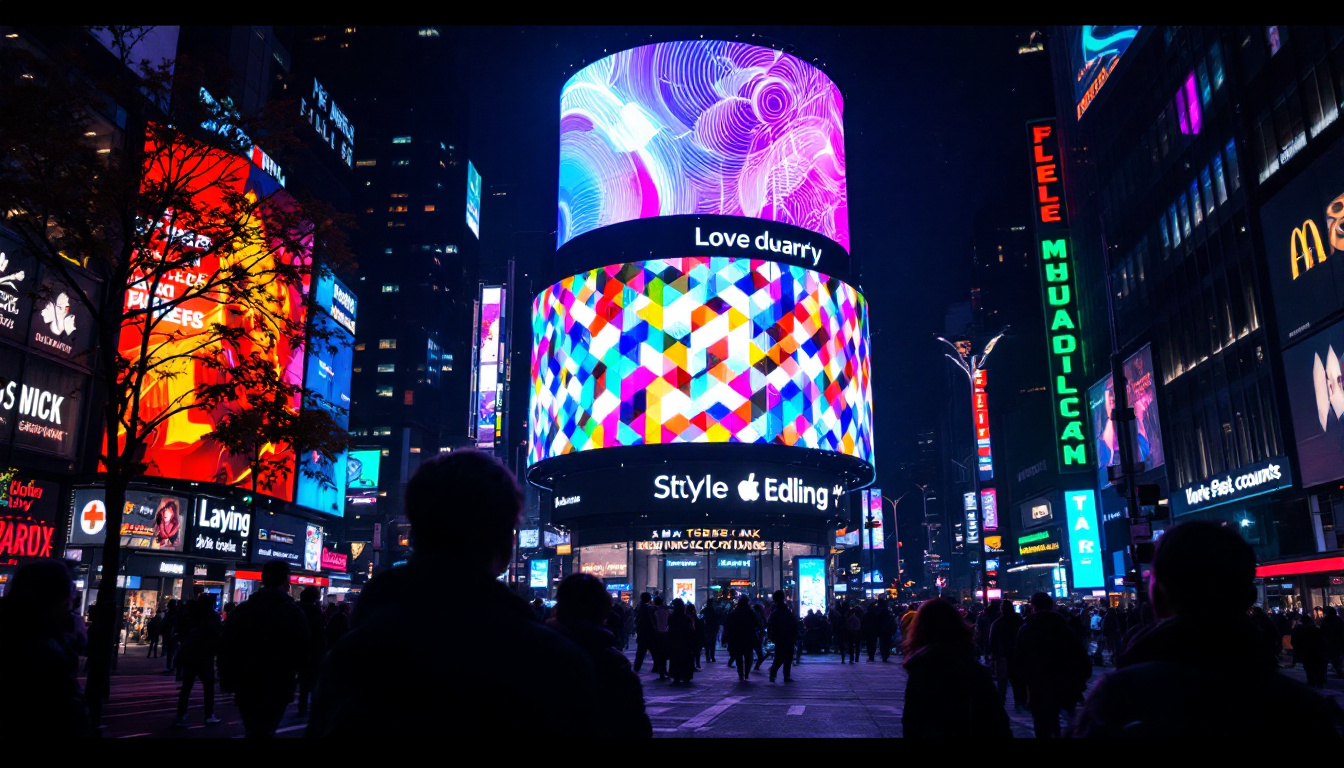Digital Signage LCD Display: LED Display Explained
In the modern world, digital signage has become an essential tool for businesses looking to engage their audience effectively. The evolution of display technology has brought about various options, among which LCD and LED displays stand out. Understanding these technologies is crucial for making informed decisions about digital signage solutions. This article delves into the intricacies of digital signage LCD displays and explains the role of LED technology in enhancing visual communication.
Understanding Digital Signage
Digital signage refers to the use of digital displays to convey information, advertisements, and other content to an audience. These displays can be found in various settings, including retail environments, corporate offices, educational institutions, and public spaces. The primary goal of digital signage is to capture attention and effectively communicate messages.
The Importance of Digital Signage
In an age where consumers are bombarded with information, digital signage offers a dynamic solution to stand out. It allows businesses to present content in an engaging manner, using animations, videos, and interactive elements. This not only attracts attention but also enhances brand recognition and customer engagement.
Moreover, digital signage can be easily updated, allowing businesses to tailor their messages based on real-time data, such as promotions, events, or even weather conditions. This flexibility makes it a powerful tool for marketing and communication strategies. For instance, a restaurant can showcase daily specials or limited-time offers, while a retail store can highlight seasonal sales or new arrivals, ensuring that the content remains relevant and appealing to customers.
Types of Digital Signage Displays
There are several types of digital signage displays, including LCD, LED, OLED, and projection systems. Each type has its unique features and benefits, making them suitable for different applications. Among these, LCD and LED displays are the most widely used due to their versatility and effectiveness. LCD displays are known for their sharp image quality and are often used in indoor environments, while LED displays are favored for their brightness and durability, making them ideal for outdoor settings.
In addition to these traditional display types, advancements in technology have introduced innovative options such as interactive kiosks and touchscreen displays. These interactive systems not only allow users to engage directly with the content but also provide a personalized experience, enhancing customer satisfaction. For example, in a museum, touchscreen displays can offer in-depth information about exhibits, allowing visitors to explore topics at their own pace. This interactivity can significantly improve the overall effectiveness of digital signage, turning passive viewers into active participants in the communication process.
What is an LCD Display?
Liquid Crystal Display (LCD) technology has been a staple in the display industry for years. LCDs utilize liquid crystals sandwiched between two layers of glass or plastic. When an electric current passes through the liquid crystals, they align to block or allow light to pass through, creating images on the screen. This innovative technology has revolutionized the way we view content, from televisions and computer monitors to smartphones and tablets, making it an integral part of modern life.
Key Features of LCD Displays
LCD displays are known for their sharp image quality and vibrant colors. They offer high resolution, making them ideal for detailed graphics and text. Additionally, LCDs have a relatively low power consumption compared to older technologies like CRTs, making them more energy-efficient. This efficiency not only reduces electricity bills but also contributes to a smaller carbon footprint, appealing to environmentally conscious consumers.
Another advantage of LCD displays is their thin profile, allowing for easy installation in various environments. They can be mounted on walls, placed on stands, or integrated into kiosks, providing flexibility in design and placement. Furthermore, advancements in LCD technology have led to the development of features such as touch sensitivity and enhanced color accuracy, which cater to a wide range of applications, from professional graphic design to interactive gaming.
Limitations of LCD Displays
Despite their many advantages, LCD displays do have some limitations. One notable drawback is their viewing angles. While modern LCDs have improved in this regard, they may still suffer from color distortion when viewed from extreme angles. This can be particularly problematic in settings where multiple viewers are watching the same screen, such as in conference rooms or movie theaters, where optimal viewing conditions are crucial for an enjoyable experience.
Additionally, LCD displays can be less effective in bright environments, as sunlight can wash out the image quality. This makes them less suitable for outdoor applications unless specifically designed for such conditions. To combat this issue, manufacturers have developed specialized outdoor LCDs with enhanced brightness and anti-glare coatings, allowing for better visibility in direct sunlight. However, these models often come at a premium price, which can be a consideration for budget-conscious buyers. As technology continues to evolve, the balance between performance and cost remains a key focus for both consumers and manufacturers alike.
What is an LED Display?
Light Emitting Diode (LED) displays are a type of digital display that uses semiconductor technology to produce light. Unlike traditional LCDs, which rely on a backlight, LED displays consist of an array of tiny LEDs that emit light directly. This technology allows for brighter images and more vibrant colors.
Advantages of LED Displays
One of the most significant advantages of LED displays is their brightness. They can produce much higher luminance levels than LCDs, making them ideal for outdoor use and environments with high ambient light. This brightness ensures that content remains visible and engaging, regardless of the surrounding conditions.
LED displays also offer superior contrast ratios, resulting in deeper blacks and more vivid colors. This enhances the overall viewing experience, making LED displays particularly appealing for advertising and entertainment applications.
Different Types of LED Displays
LED displays come in various configurations, including direct-view LED, LED-backlit LCD, and organic LED (OLED). Direct-view LED displays are often used for large-scale installations, such as billboards and stadium screens, while LED-backlit LCDs combine the benefits of both technologies for improved performance.
OLED technology, a subset of LED displays, utilizes organic compounds to produce light. This allows for even thinner displays and better color accuracy, making OLED a popular choice for high-end applications.
Comparing LCD and LED Displays
When choosing between LCD and LED displays for digital signage, several factors need to be considered. Each technology has its strengths and weaknesses, and understanding these can help businesses make the right choice for their specific needs.
Image Quality and Performance
In terms of image quality, LED displays generally outperform LCDs. The ability to produce higher brightness levels and better contrast ratios gives LED displays an edge, especially in challenging lighting conditions. However, high-end LCDs can still provide excellent image quality, particularly in controlled environments.
For applications that require vibrant colors and high visibility, LED displays are often the preferred choice. Conversely, LCDs may be more suitable for indoor environments where lighting conditions are manageable.
Cost Considerations
Cost is another critical factor when comparing LCD and LED displays. Typically, LED displays tend to be more expensive than their LCD counterparts. However, the long-term benefits of LED technology, such as lower maintenance costs and energy efficiency, can offset the initial investment over time.
Businesses should consider their budget and the expected return on investment when deciding between these two technologies. In some cases, the enhanced performance of LED displays may justify the higher upfront cost.
Applications of LCD and LED Displays
Both LCD and LED displays have diverse applications across various industries. Understanding these applications can help businesses determine which technology is best suited for their needs.
Retail Environments
In retail settings, digital signage plays a crucial role in attracting customers and promoting products. LCD displays are often used for in-store promotions, product information, and interactive kiosks. Their ability to present detailed graphics makes them ideal for showcasing products effectively.
On the other hand, LED displays are commonly used for outdoor advertising, billboards, and large-scale promotions. Their brightness and visibility ensure that messages reach a broader audience, even in direct sunlight.
Corporate and Educational Settings
In corporate environments, digital signage is used for internal communications, wayfinding, and event information. LCD displays are favored for conference rooms and lobbies, where clear and detailed information is essential.
Educational institutions also benefit from digital signage, using LCD displays for announcements, schedules, and educational content. LED displays can be found in auditoriums and sports facilities, providing dynamic visuals for events and presentations.
Future Trends in Digital Signage
The digital signage industry is continually evolving, driven by advancements in technology and changing consumer preferences. Several trends are shaping the future of digital signage displays, particularly in the realm of LCD and LED technologies.
Integration with IoT and AI
As the Internet of Things (IoT) and artificial intelligence (AI) become more prevalent, digital signage is set to become smarter and more interactive. Displays will increasingly be able to gather data, analyze viewer behavior, and adjust content in real-time to enhance engagement.
This integration will allow businesses to deliver personalized messages based on audience demographics, preferences, and even location. The result will be a more tailored experience for consumers, leading to improved engagement and conversion rates.
Advancements in Display Technology
Future advancements in display technology will continue to enhance the capabilities of LCD and LED displays. Innovations such as microLED and miniLED technologies promise to deliver even better image quality, energy efficiency, and form factors.
These advancements will enable the creation of thinner, lighter displays with improved performance, opening up new possibilities for creative installations and applications in various industries.
Conclusion
Digital signage has transformed the way businesses communicate with their audiences, and understanding the differences between LCD and LED displays is essential for making informed decisions. Both technologies offer unique advantages and applications, catering to various needs and environments.
As digital signage continues to evolve, staying abreast of the latest trends and innovations will be crucial for businesses looking to leverage this powerful communication tool effectively. Whether opting for the vibrant visuals of LED displays or the detailed graphics of LCDs, the right choice will ultimately depend on the specific requirements and goals of the organization.
Investing in digital signage is not just about choosing the right display technology; it’s about enhancing communication, engaging audiences, and driving results in an increasingly competitive landscape.
Discover LumenMatrix’s Innovative LED Solutions
Ready to elevate your digital signage strategy with the latest in LED technology? Look no further than LumenMatrix, where innovation meets visual excellence. Our extensive range of LED display modules, from vibrant Indoor and Outdoor LED Wall Displays to dynamic Vehicle and Sports LED Displays, is designed to captivate your audience and amplify your message. Experience the future of visual communication with our cutting-edge solutions, including Custom LED Displays and All-in-One LED Display options. Don’t miss the opportunity to transform your brand’s presence. Check out LumenMatrix LED Display Solutions today and make a lasting impression.































